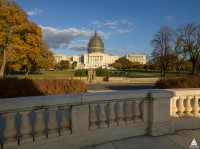 Scaffolding around the cast iron Dome of the U.S. Capitol in Washington, D.C., has been completed so that the full restoration of the Dome can begin. The construction of the scaffolding system is an impressive project in its own right. More than 52 miles of metal piping and two miles of wood planking form 25 tiers of platforms that surround the Dome from the skirt up to the base of the Statue of Freedom. The total weight of the scaffolding materials is 1.1 million pounds. Work is expected to take about two years and will be done mainly at night so as to minimize the disruption of Congressional business.
Scaffolding around the cast iron Dome of the U.S. Capitol in Washington, D.C., has been completed so that the full restoration of the Dome can begin. The construction of the scaffolding system is an impressive project in its own right. More than 52 miles of metal piping and two miles of wood planking form 25 tiers of platforms that surround the Dome from the skirt up to the base of the Statue of Freedom. The total weight of the scaffolding materials is 1.1 million pounds. Work is expected to take about two years and will be done mainly at night so as to minimize the disruption of Congressional business.
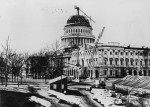 It’s been 150 years since the Dome was constructed, and although it was refurbished once in 1960, it’s in dire need of extensive repairs. Age and weathering have caused almost 1,300 cracks and breaks, 12,800 inches worth, in the exterior skin. There are pits and voids, rusted areas, missing and loose ornaments. So far workers have collected more than 100 ornaments that had either fallen off or were just about to fall off. Water leaks in through the cracks and pinholes in the Statue of Freedom causing rust and damage to the protective paint and corrosion in the interstitial space between the Dome and the Rotunda.
It’s been 150 years since the Dome was constructed, and although it was refurbished once in 1960, it’s in dire need of extensive repairs. Age and weathering have caused almost 1,300 cracks and breaks, 12,800 inches worth, in the exterior skin. There are pits and voids, rusted areas, missing and loose ornaments. So far workers have collected more than 100 ornaments that had either fallen off or were just about to fall off. Water leaks in through the cracks and pinholes in the Statue of Freedom causing rust and damage to the protective paint and corrosion in the interstitial space between the Dome and the Rotunda.
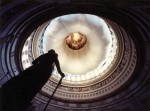 These are critical condition issues that need immediate attention lest the artwork in the Rotunda, the Apotheosis of Washington in the oculus of the Dome and the Frieze of American History underneath the windows, are at great risk of damage due to water leaks. There are already noticeable water stains on the coffers at the first visitors’ gallery. Further damage could cause things to start breaking off onto visitors in the Rotunda. A white donut-shaped catenary system was installed above the Frieze to protect visitors and the floor from construction debris while leaving the Apotheosis and Frieze still viewable.
These are critical condition issues that need immediate attention lest the artwork in the Rotunda, the Apotheosis of Washington in the oculus of the Dome and the Frieze of American History underneath the windows, are at great risk of damage due to water leaks. There are already noticeable water stains on the coffers at the first visitors’ gallery. Further damage could cause things to start breaking off onto visitors in the Rotunda. A white donut-shaped catenary system was installed above the Frieze to protect visitors and the floor from construction debris while leaving the Apotheosis and Frieze still viewable.
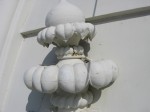 Now that the scaffolding is up, the next stage is paint abatement and removal. Workers will sand blast eight layers of paint, some of it lead paint, some of it dating to 1866 when the first paint was applied to the completed Dome. To do this safely, the paint will sucked into large tubes that will run from the scaffolding to specialized trucks parked on the lower West Front of the Capitol. During this process, workers will also remove all loose ornaments and anything else precarious. Conservators will restore whatever pieces they can and recast the ones that are too damaged to repair.
Now that the scaffolding is up, the next stage is paint abatement and removal. Workers will sand blast eight layers of paint, some of it lead paint, some of it dating to 1866 when the first paint was applied to the completed Dome. To do this safely, the paint will sucked into large tubes that will run from the scaffolding to specialized trucks parked on the lower West Front of the Capitol. During this process, workers will also remove all loose ornaments and anything else precarious. Conservators will restore whatever pieces they can and recast the ones that are too damaged to repair.
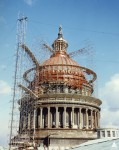 As soon as the paint is removed, a primer coat will be applied. Cast iron is subject to “flash rusting,” meaning it starts to oxidize instantly as soon as it’s exposed to oxygen. To prevent flash rusting, the Dome will have to be primed within eight hours of paint removal. After the entire Dome is primed, the cracks in the cast iron will be repaired. Welding doesn’t work with cast iron unless you disassemble the object and bake it an oven at 1000 degrees Fahrenheit, a technique that obviously doesn’t apply to a giant dome. Of the 12,800 crack inches, 8,200 of them will be repaired using a technique called “lock and stitch” in which each crack is filled by hand with metal pins (that’s the stitching part) and then the edges brought together across the width with steel locks. The rest of the cracks will be filled with the “Dutchman” technique wherein large pieces are replaced with parts of the same shape. The restored or recast ornamentation will then be readded and damaged windows replaced and repaired.
As soon as the paint is removed, a primer coat will be applied. Cast iron is subject to “flash rusting,” meaning it starts to oxidize instantly as soon as it’s exposed to oxygen. To prevent flash rusting, the Dome will have to be primed within eight hours of paint removal. After the entire Dome is primed, the cracks in the cast iron will be repaired. Welding doesn’t work with cast iron unless you disassemble the object and bake it an oven at 1000 degrees Fahrenheit, a technique that obviously doesn’t apply to a giant dome. Of the 12,800 crack inches, 8,200 of them will be repaired using a technique called “lock and stitch” in which each crack is filled by hand with metal pins (that’s the stitching part) and then the edges brought together across the width with steel locks. The rest of the cracks will be filled with the “Dutchman” technique wherein large pieces are replaced with parts of the same shape. The restored or recast ornamentation will then be readded and damaged windows replaced and repaired.
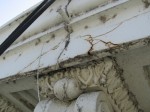 All of that work will be done from the boiler plate at the bottom of the Dome to the base of the Statue of Freedom. The next phases will be done from top to bottom so the scaffolding can be removed as work is completed. Cast iron filler will be applied to any areas in need of it, then the Dome will be repainted in three layers. The top coat will be, appropriately enough, Dome White. Next fall protection and bird deterrent systems will be installed. After that, all that will be left is the clean-up. Everything should be shiny and new for the 2017 Presidential Inauguration.
All of that work will be done from the boiler plate at the bottom of the Dome to the base of the Statue of Freedom. The next phases will be done from top to bottom so the scaffolding can be removed as work is completed. Cast iron filler will be applied to any areas in need of it, then the Dome will be repainted in three layers. The top coat will be, appropriately enough, Dome White. Next fall protection and bird deterrent systems will be installed. After that, all that will be left is the clean-up. Everything should be shiny and new for the 2017 Presidential Inauguration.
 The Architect of the Capitol has made tons of fascinating photographs of the Capitol dome available on its Flickr page. The main photostream has current pictures, plus there are photo albums dedicated to subjects like the original construction of the iron dome in the 1850s and 60s, the 1960 restoration, the restoration of the Brumidi frescos inside the Capitol and a set of almost 300 images of the restoration that began this month. The there are all the pictures of various events, holidays, seasons and oh man, the Capitol artwork. It’s seriously one of the greatest Flickr accounts I’ve ever seen.
The Architect of the Capitol has made tons of fascinating photographs of the Capitol dome available on its Flickr page. The main photostream has current pictures, plus there are photo albums dedicated to subjects like the original construction of the iron dome in the 1850s and 60s, the 1960 restoration, the restoration of the Brumidi frescos inside the Capitol and a set of almost 300 images of the restoration that began this month. The there are all the pictures of various events, holidays, seasons and oh man, the Capitol artwork. It’s seriously one of the greatest Flickr accounts I’ve ever seen.